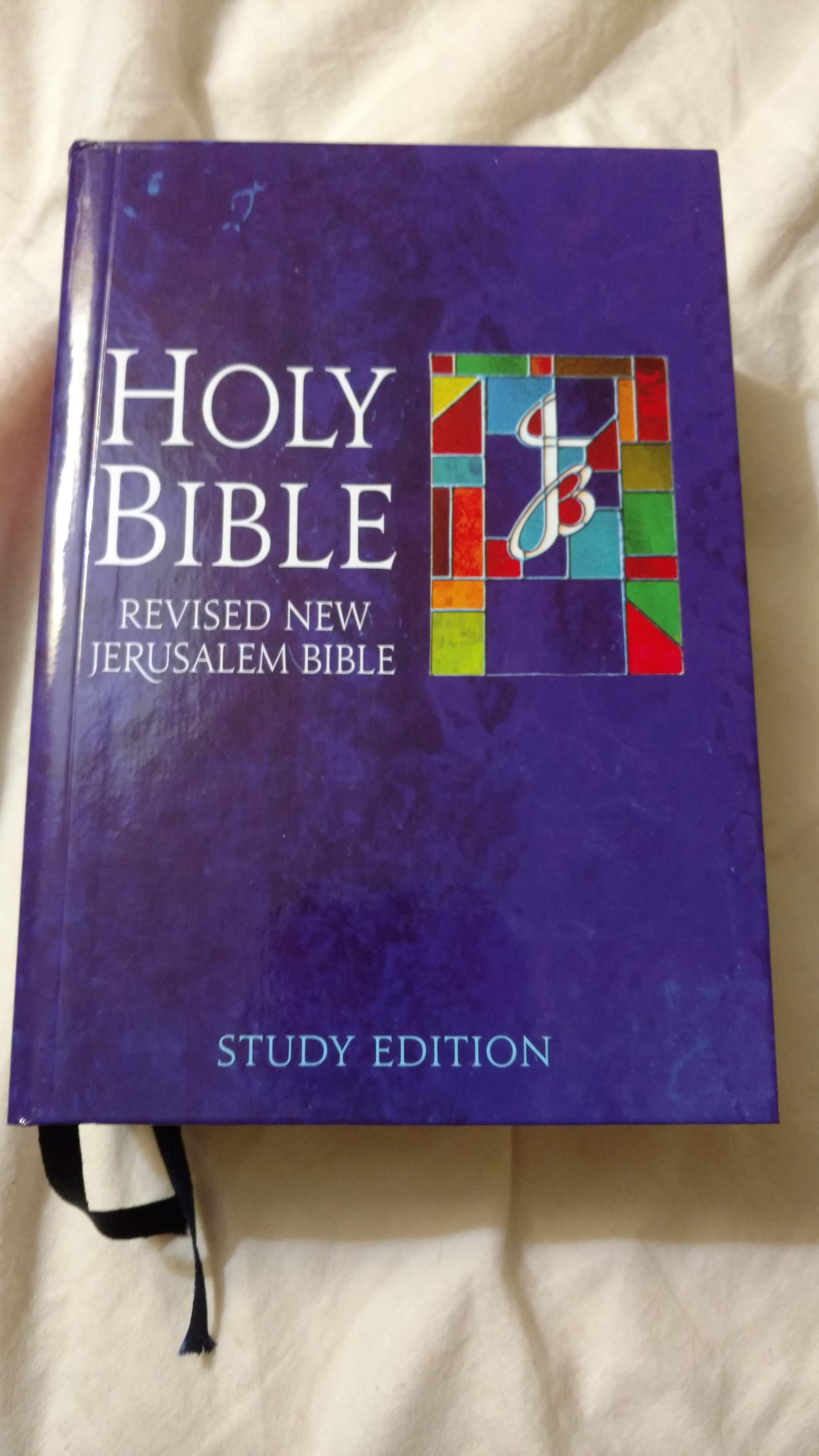
Jeff Sagarin has already received the Revised New Jerusalem Bible (RNJB) in the mail from Book Depository! He sent a first batch of photos yesterday with a selection of the passages readers requested in last week’s post. There will be more photos to come!
As a brief overview, this is a hardcover bible which measures 5.4 inches X 7.8 inches (137 mm X 198 mm). It is printed in a single-column format, in the venerable tradition of the Jerusalem Bible and the New Jerusalem Bible. The bible features two ribbon markers, and from what we can tell so far, it appears to have a sewn binding.
Here is a photo of the copyright page, with the nihil obstat and imprimatur:
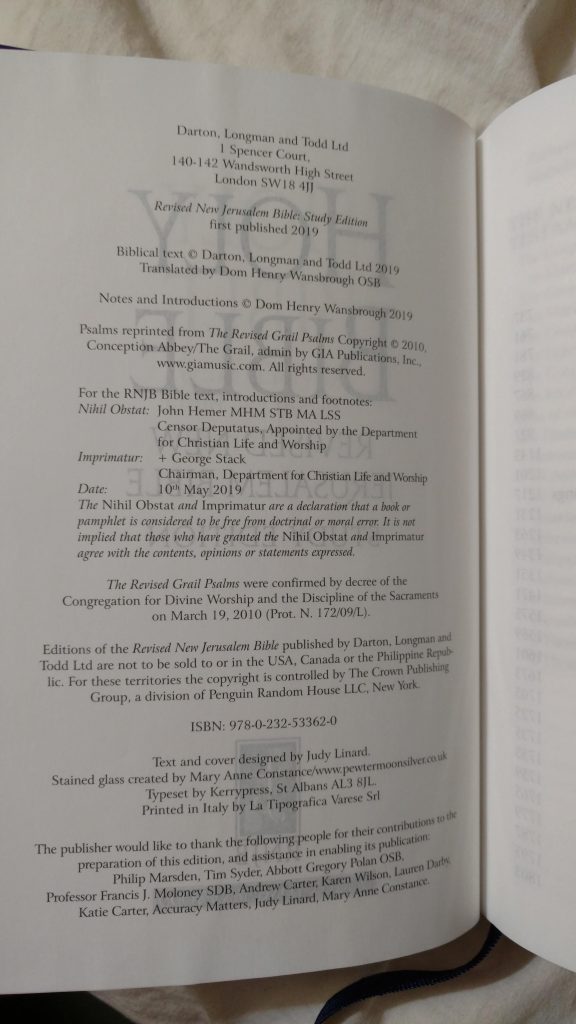
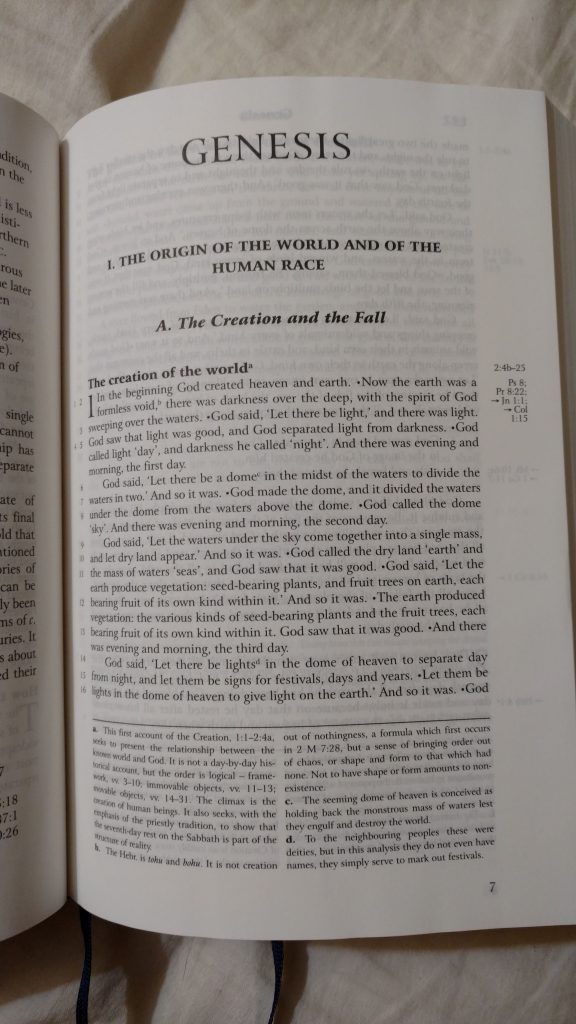
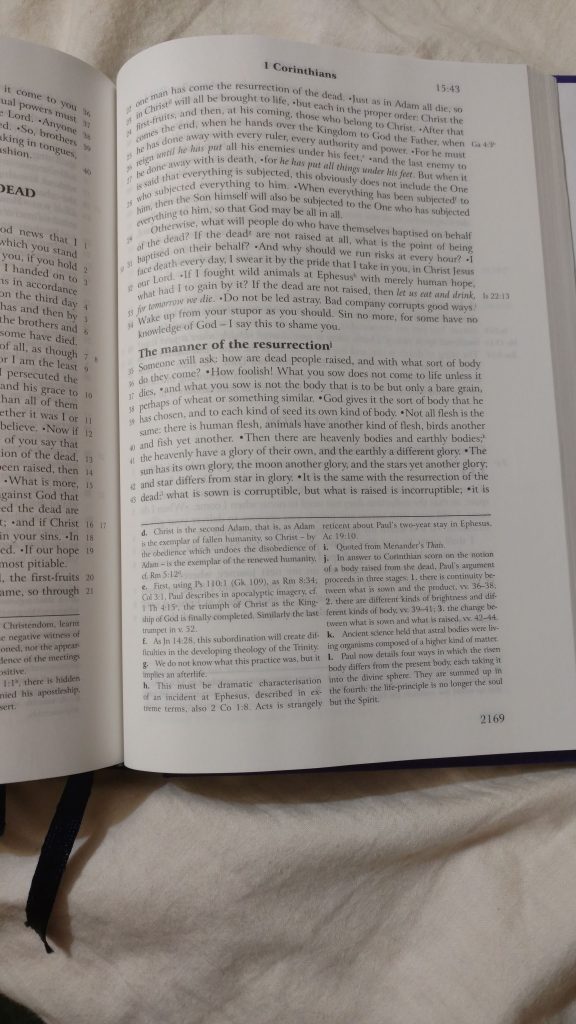
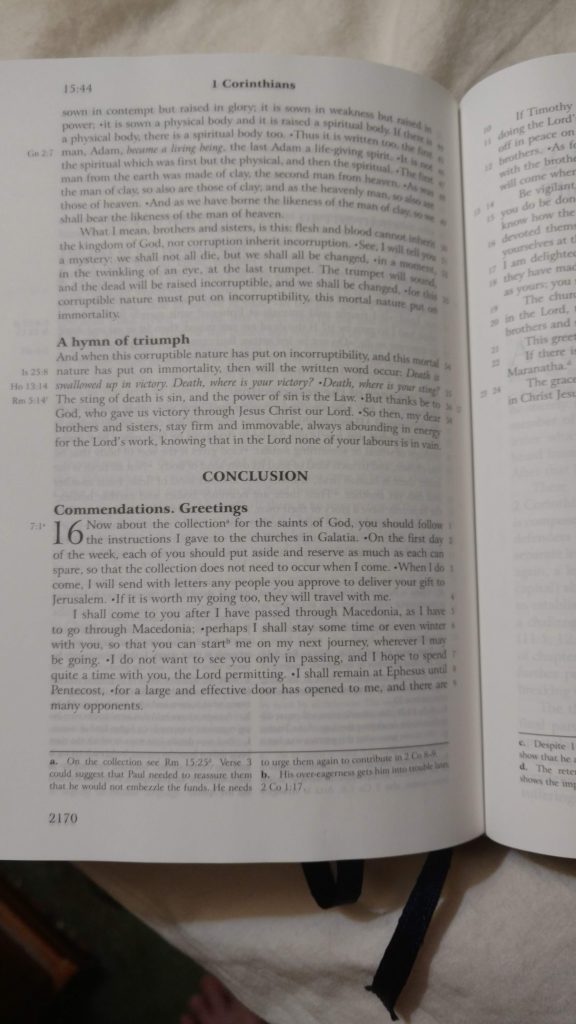
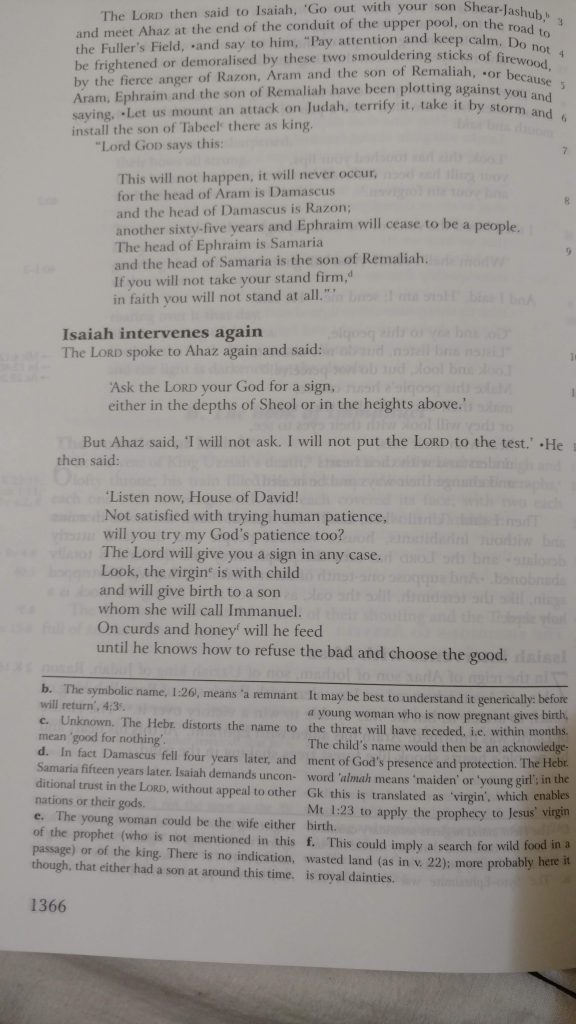
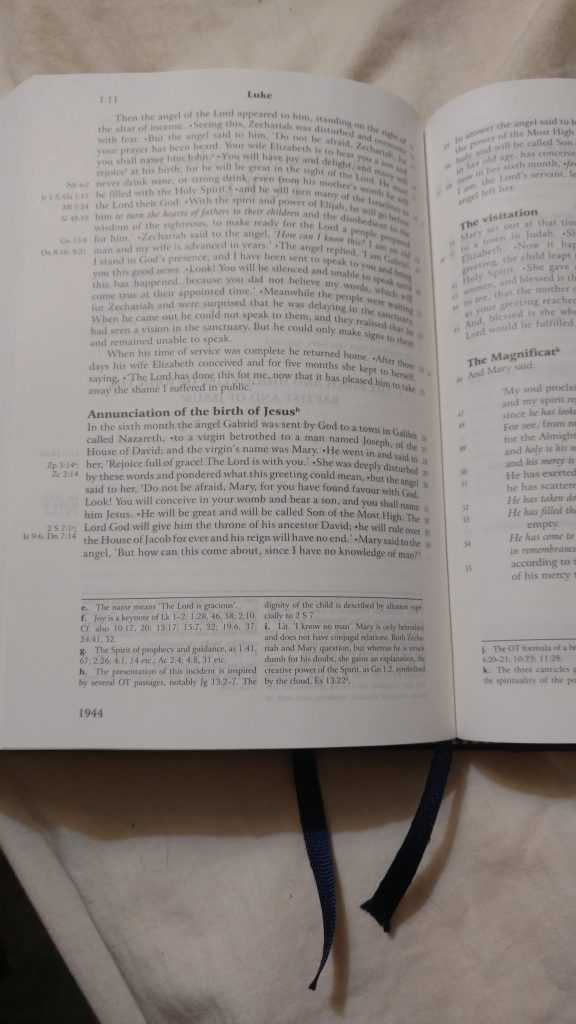
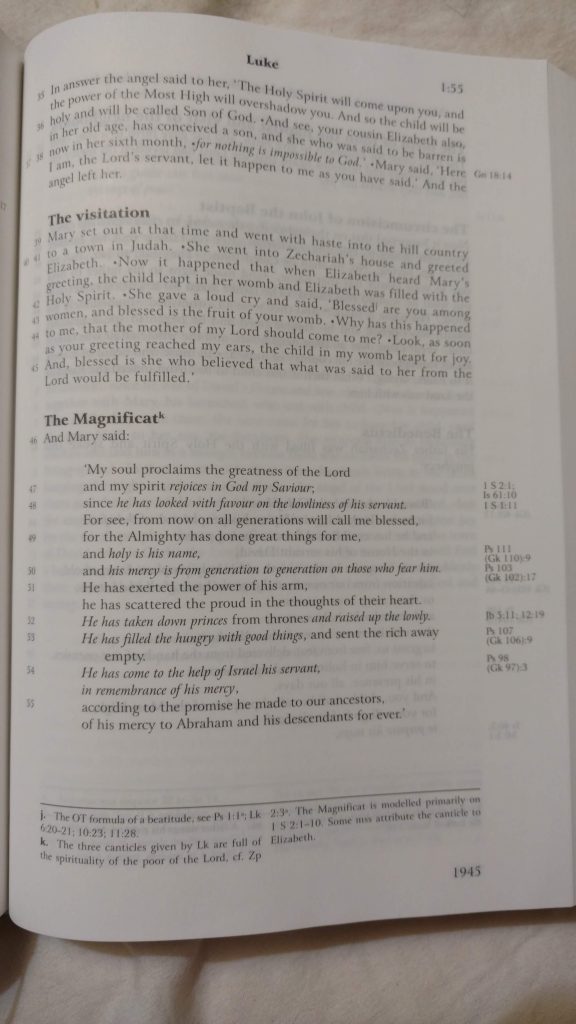
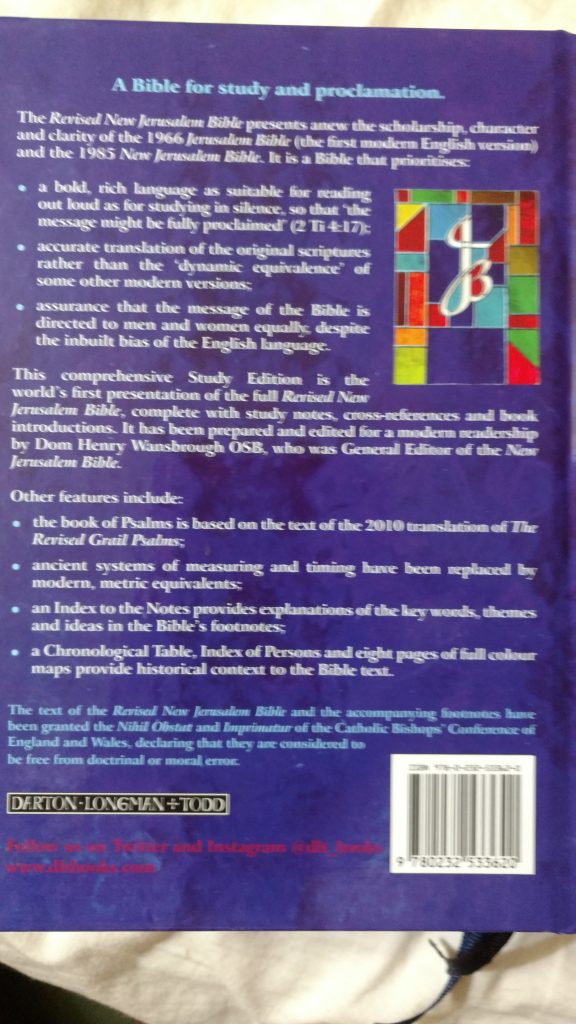
I am curious about the depth measurement?
Me too! Jeff, if you’re watching the comments, could you measure the thickness of this bible?
Christianbook.com lists the depth as two inches.
Thickness including both covers is between 62 and 65 mm, depending on how tight you squeeze it closed. In other words roughly 2.5 inches.
The reason for Christianbook having a smaller thickness is that they are referencing the USA printing by PenguinRandomHouse which will be in February 2020 (eBook in December 2019).
The USA printing will have larger dimensions for the pages and so that printing will “only” have 2208 pages because of more information on each page. The DLT printing from England has 2416 pages.
This is from Christianbook website
Product Description
Originally published in 1966, the Jerusalem Bible is one of the outstanding translations of our day. A revision was completed in 1985 that compared the text more closely to the original Greek and Hebrew, while striving to be faithful to modern English expressions. Now the text and apparatus have undergone a complete transformation. 2208 pages, 6″ x 9″ x 2″ hardcover. Image.
Product Information
Title: Revised New Jerusalem Bible
By: Henry Wansbrough
Format: Hardcover
Number of Pages: 2208
Vendor: Image
Publication Date: 2019
Dimensions: 9.25 X 6.13 (inches)
ISBN: 0525573194
ISBN-13: 9780525573197
Text Color: Black Letter
Stock No: WW573197
Interestingly enough, the PenguinRandomHouse website still says 2416 pages but
given the larger page size, should be less pages. Unless of course they are still printing
the same stuff on each page but with a larger font. Could be.
https://www.penguinrandomhouse.com/books/566253/the-revised-new-jerusalem-bible-by-translated-by-henry-wansbrough/9780525573197/
Product Details
Hardcover | $59.95
Published by Image
Dec 03, 2019 | 2416 Pages | 6 x 9-1/4 | ISBN 9780525573197
Product Details
Ebook | $19.99
Published by Image
Dec 03, 2019 | 2416 Pages | ISBN 9780525573203
And you’ll see that for both the hardcover and Ebook, the release date is December 3, 2019,
a Tuesday. I’ll call PenguinRandomHouse later today and try to get ahold of someone there who knows what’s going on and report back here.
I think I might pass on this Bible for now. It sounds really promising as a translation but I assume eventually there will be another edition that is a bit more compact. Especially if it get picked up as the lectionary text of the British Isles.
Jeff, Thank you for taking the time to show the previews. I’m curious: is the text fairly readable, given the size of the Bible? It looks like its similar to the font size of the RNJB New Testament/Psalms edition that came out last year. And I wanted to confirm that it is sewn, as Marc believes to be the case. Thanks!
And we have an imprimatur!
Robert,
I believe it is sewn, and I sent Marc and Tim a picture showing that which is Marc
thinks it’s sewn. And as long as I have my reading glasses on, I can read everything relatively easily, including the footnotes. And yes, I think it may be the same size font as last year’s release of the NT & Psalms. I think it’s fascinating that
Luke 1:28 is now “Rejoice full of grace!”, while last year it was
“Rejoice, favoured one!”
Jeff, thanks. It is indeed sewn. I just received my copy in the mail. It’s a beautiful edition given the price. I don’t expect them to release it in genuine or premium leather, so this may be as good as it gets, but I think it’s a comfortable size, with a readable print and very nice font. I see this being a long-timer for me.
I was so happy to see the “full of grace,” among other improvements over the NJB.
I’ll keep the NJB close at hand for the Dominican notes, though, as they’re much more comprehensive. The notes in this edition are nice in that they’re concise, especially for taking around (rather than keeping on the desk).
I received my copy several days ago. This is a beautiful translation that reads beautifully. The NRJB will be a treasure for years to come.
Big kerfuffle across the pond over the RNJB:
https://www.thetablet.co.uk/news/11955/war-of-the-word-top-scholars-battle-over-bible-translations
Professor Eamon Duffy has criticized the RNJB, especially as potentially used in the lectionary. And he has in turn been criticized.
https://www.thetablet.co.uk/news/11955/war-of-the-word-top-scholars-battle-over-bible-translations
Ah….more bible wars. How long must we sing this song?
How long? Until the Second Coming. People can’t even agree on which Greek NT text is the best or whether the Masoretic text represents an older or younger tradition than the Vulgate. There is no way anyone is going to agree on something as prosaic as an English translation.
I’m surprised at the number of traditional renderings in this Bible.
– “In the beginning God created heaven and earth.”
– The “spirit of God” (not a mighty wind) sweeping over the waters.
– “Virgin” in Isaiah 7:14.
– “full of grace”
I am a tad tempted to ask if Fr. Wansbrough really believed in all of these translation choices as the most accurate possible choices, or if he was angling a bit for getting the translation used in the liturgy, but I suppose there’s no reason to by cynical.
I’m not thrilled about the inclusive language, but I am still trying to get a handle on how extensive it is (I requested some passages in the other thread that might shed some light). It would be nice to know if Fr. Wansbrough tried to eliminate masculine references to God where he could get away with it as the NRSV did, but I don’t have a list of passages to check for that.
I am downright upset about the use of “physical body” in 1 Corinthians 15:44, which (as I believe a blog post on this very blog discussed) is pretty much a blatant mistranslation of the Greek. It is especially disappointing when the Jerusalem Bible had such a great (albeit somewhat dynamic) rendering of that passage.
response to Plotinus: comparing the gold-standard Douay-Rheims with the RNJB,
it would seem to be the same idea(s) conveyed in each. I don’t see any contradictions
between them.
Here’s the Douay-Rheims (Loreto) wording of 1 Corinthians 15:44
“44 It is sown a natural body,it shall rise a spiritual body.
If there be a natural body, there is also a spiritual body, as it is written:
45 The first man Adam was made into a living soul; the last Adam into a quickening spirit.”
Here is the new RNJB wording:
“44 It is sown a physical body and it is raised a spiritual body.
If there is a physical body, there is a spiritual body too. Thus it is written too,
45 the first man, Adam, became a living being, the last Adam, a life-giving spirit.”
It is very common to translate the terms in 1 Cor 15:44 as “natural body” or “physical body,” so the RNJB is certainly in good company. I agree with Plotinus, though. I covered the nuances of this verse in a post about a year ago here:
http://catholicbibletalk.com/2018/08/bible-study-tidbit-the-resurrection-body/
NT Wright suggests that a better (but less understandable) translation would be “soulish body,” because Paul seems to be distinguishing between a body animated by a normal soul versus a body animated by the Holy Spirit. The sense of 1 Cor 15:44 could be captured like this: “It is sown as a body animated by the ordinary breath of life (or alternatively, a human soul); it is raised a body animated by the Spirit of the living God.” The original Jerusalem Bible did a nice job with this verse, by translating it as follows: “when it is sown it embodies the soul, when it is raised it embodies the spirit.”
I wonder if a formal equivalence style pushes translators to choose words that are imperfect equivalents in order to preserve a “word-for-word” equivalence. Sometimes there is no single word in another language that has the same meaning. In that case, paraphrasing the original could lead to a more accurate rendering.
I wonder if this translation would ever be adopted in part or in whole by the USCCB for the Lectionary in the US. I feel like finding a good up-to-date Catholic Bible is quite the quest, I try to balance ecumenism and academic rigor with Catholic liturgical substance and ecclesial acceptance. So far the RNJB has achieved this, but I actually have the NJB (1985) since I love the format and cover art, it’s a beautiful translation as a Reader’s Edition. I think I’ve ruled out the NRSV-(CE) as too white-washed and overly edited like a resurrected KJV zombie. The RSV-(1&2)CE is favored by people like the Navarre Bible commentary and Trent Horn but I find it increasingly obsolete and lacks the academic rigor that say the NAB-line if translations have. Whereas… The NAB-RE just seems like it has an identity crisis as it is in constant revision and is not even considered complete yet, I find this very peculiar but perhaps it’s a witness to the vast “suspense” of Catholic speculation on what is ideal for liturgical custom. To me the NJB is the best we’ll ever have in terms of uniqueness/originality and ecumenical as well as academic substance, I’d rather choose one Bible and read from it daily than be in constant “suspense” with regard to the Churches crises of decision on Lectionary/Liturgy and Worship.
No. The USCCB owns the NAB copyright, and plans to have the final revision completed in just 2 years, so they would have literally no reason to consider the RNJB. On the subject, one big issue I have with the RNJB Study Edition is that I really wish it didn’t gut all the NJB’s comprehensive notes. In fact, the haphazard treatment of the notes resulted in a few mistakes in some of those that remain, stemming from the fact that some are still keyed to the NJB text, even where the RNJB made a change. See, for example, the notes on Gen. 3:15, Dan. 10:21, and Rev. 1:10. I’m curious if these were ever corrected since December 2019.